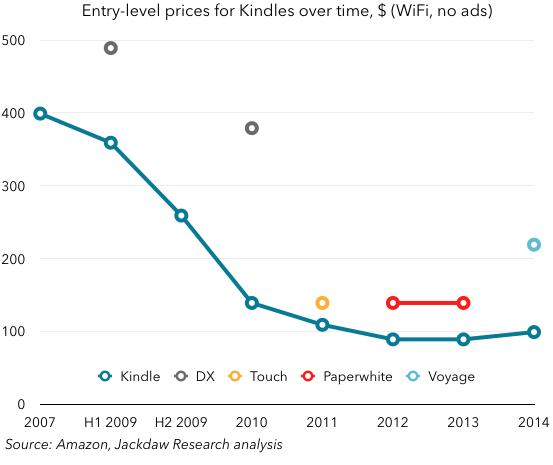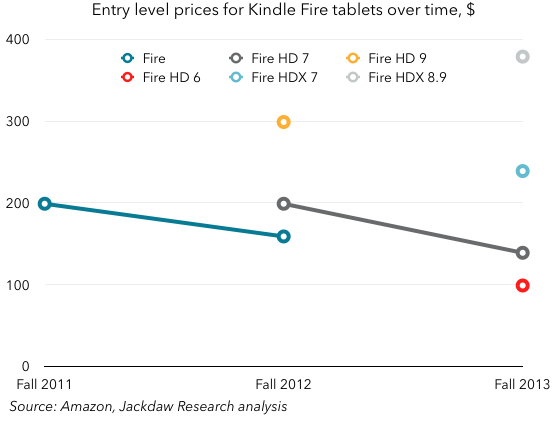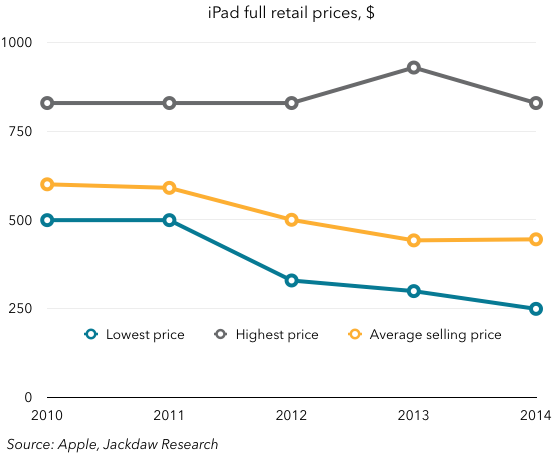I’ve referred to this in passing in several different posts, but I wanted to really devote some time to both researching and writing up a particular trend: Amazon’s changing approach to hardware, and especially the pricing of its hardware.
Kindle: Amazon’s successful hardware product
The Kindle e-reader was Amazon’s first hardware product, and is arguably its only truly successful hardware product too. It has three key characteristics that make it successful:
- It offers exclusive functionality: it’s the only dedicated e-reader that is designed from the ground up to work with Amazon’s Kindle ebooks.
- It’s tied exclusively to content sold through Amazon: Kindles are designed for one thing, and one thing only: reading books purchased from the Kindle store. Yes, it’s technically possible to read some free content and content from other sources, but for all intents and purposes Kindles are storefronts for Kindle books and aren’t really useful unless its users are buying those books.
- It’s competitively priced: although Amazon’s first Kindles cost several hundred dollars, prices quickly dropped, especially as Amazon began selling the devices at, near, or even below cost.
When Amazon debuted the Kindle Fire category, it took in some ways a similar approach, pricing the devices very competitively, at well below what comparable tablets were going for, and the devices were heavily focused on content purchased through Amazon. The exclusive element wasn’t so much in the functionality, however, as in getting that functionality for the price Amazon was charging. But since then, the strategy has diverged further and further from the original strategy that made the Kindle so successful, and Amazon’s other recent devices – the Fire Phone and Fire TV – have arguably continued the pattern.
We never did see those free Kindles promised in 2011
It’s worth looking at the history of pricing for the Kindle and Kindle Fire lines to see how Amazon has handled pricing since the early versions. The chart below shows baseline pricing (WiFi only, no ads) for Kindles since their inception:
 It’s no wonder that there was a slew of articles in late 2011 asking when Kindles would be free, or predicting that they certainly would be shortly (see here, here and here). That was partly just extrapolation from the obvious trend line, but it also seemed to fit with Amazon’s razors-and-razor-blades model for the Kindle. However, what happened in 2012 and beyond was not at all what so many predicted. The baseline price of the Kindle stopped falling in 2012, and the next edition (launched in 2014) actually cost more. The price discount offered on the version with ads masks this a little bit, but the reality is that Kindle prices aren’t falling at all, and in fact they’re rising. If you layer in the other Kindle versions, the baseline price for the more expensive version has actually risen again as well, with the launch of the Kindle Voyage.
It’s no wonder that there was a slew of articles in late 2011 asking when Kindles would be free, or predicting that they certainly would be shortly (see here, here and here). That was partly just extrapolation from the obvious trend line, but it also seemed to fit with Amazon’s razors-and-razor-blades model for the Kindle. However, what happened in 2012 and beyond was not at all what so many predicted. The baseline price of the Kindle stopped falling in 2012, and the next edition (launched in 2014) actually cost more. The price discount offered on the version with ads masks this a little bit, but the reality is that Kindle prices aren’t falling at all, and in fact they’re rising. If you layer in the other Kindle versions, the baseline price for the more expensive version has actually risen again as well, with the launch of the Kindle Voyage.
Kindle Fires have also been getting more expensive
Now, look at the equivalent chart for the Kindle Fire:
 The trend here is harder to spot, because Amazon hasn’t stuck with a single model throughout the history, rather introducing a series of new models over time. But you can see two distinct trends: individual models have come down in price over time (in the case of the original Fire and the HD 7), while new versions are being introduced at higher prices, actually raising the upper price over time. Amazon has lowered the entry-level price (and you very much get what you pay for at that level) but it’s also moving up the stack into the premium space. The highest base-level price has moved from $200 to $300 to just under $400 over this time.
The trend here is harder to spot, because Amazon hasn’t stuck with a single model throughout the history, rather introducing a series of new models over time. But you can see two distinct trends: individual models have come down in price over time (in the case of the original Fire and the HD 7), while new versions are being introduced at higher prices, actually raising the upper price over time. Amazon has lowered the entry-level price (and you very much get what you pay for at that level) but it’s also moving up the stack into the premium space. The highest base-level price has moved from $200 to $300 to just under $400 over this time.
Let’s go back to the original Kindle model for a second and see how the new line of Kindle Fires stacks up:
- Exclusive functionality – a key problem for the Kindle Fire line all along has been that they offered no exclusive functionality, only exclusive access to widely-available functionality at a low price
- Exclusive ties to Amazon content – one of the key problems for the Kindle Fire line is that they could be used for plenty of things that didn’t require another purchase from Amazon. As such, the razor blades and razors model fundamentally didn’t work
- Competitive pricing – as a result of both of these, Amazon hasn’t been able to keep the prices low, and instead has had to raise prices over time for the most capable tablets in order to truly cover costs.
That last point is the key here: Amazon can’t sell other products on the same basis as it originally sold Kindles because those other products don’t have the same positive effect on other sales as Kindles do. Even Kindles can only be discounted so far before they become loss-making, presumably, even taking into account e-book sales. As a result, both the Kindle itself and Amazon’s other products have been priced increasingly like competing products, at modest to decent gross margins, rather than being sold at cost, because there simply is no significant indirect revenue opportunity from selling these devices. As such, these devices have to be revenue and margin generators in their own right, rather than driving content revenue for Amazon (especially since Amazon has turned video consumption into a Prime perk, rather than a revenue source of its own).
For all these reasons, neither the Fire Phone nor the Fire TV could be priced the way the early Kindles were, because they have to cover their own costs when it comes to revenues. But because many people haven’t understood this shift that’s happened in Amazon’s hardware pricing strategy, they’ve been surprised by the pricing of both devices, which was higher than many expected. Interestingly, the Fire TV stick is the one exception to all this, as the equivalent of those cheap Fire tablets, with more limited functionality at rock-bottom prices. As a result, it’s also sold very well (it’s Amazon’s top-selling electronics device as I write this).
But the implication of all this is that Amazon has lost the two things that made its hardware so compelling in earlier versions, and it’s also lost much of the benefit of selling the devices from the perspective of its other businesses. As such, it should at this point scale back its hardware activities (which are apparently troubled in other ways) and focus on those hardware products which exhibit the same characteristics as its earlier, successful products. That means dramatically paring back its hardware activities, which I’m not convinced the company is ready to do yet. But it’s essential.
Postscript: compare all this to the iPad
It’s interesting to compare all this to the iPad, and what’s happened to its price over the last few years. This is a slightly different chart, in that it shows both the highest and lowest price as well as the average selling price, but it’s comparable:
 What you can see is that Apple has slowly lowered the lowest price of the iPad, partly by keeping older models on sale, and partly by introducing the iPad Mini, such that the entry-level price is now half what it was in 2010, when the device first launched. Notably, though, in contrast to Amazon, it hasn’t done this by creating ever cheaper, crappier tablets, but by keeping very good older tablets in market. It’s also kept the high end of the spectrum remarkably constant, with only a brief blip in 2013 when it introduced a new storage tier. Meanwhile, the average selling price fell for a while and has now stabilized somewhat.
What you can see is that Apple has slowly lowered the lowest price of the iPad, partly by keeping older models on sale, and partly by introducing the iPad Mini, such that the entry-level price is now half what it was in 2010, when the device first launched. Notably, though, in contrast to Amazon, it hasn’t done this by creating ever cheaper, crappier tablets, but by keeping very good older tablets in market. It’s also kept the high end of the spectrum remarkably constant, with only a brief blip in 2013 when it introduced a new storage tier. Meanwhile, the average selling price fell for a while and has now stabilized somewhat.
Apple has pursued in some ways the opposite strategy to Amazon, as it often does. It comes in at a relatively high price, giving it the healthy margins it expects while also leaving room for future price discounts. What was so amazing with the iPad, of course, was that it cost far less than people expected even in its original version.